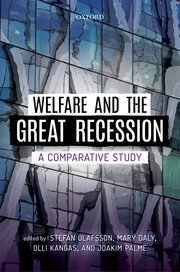
Welfare and the Great Recession: A Comparative Study edited by Stefán Ólafsson, Mary Daly, Olli Kangas, and Joakim Palme

Ten years after the first economic crisis of twenty-first century capitalism, Europe seems to have passed the nadir of the Great Recession. Time to count our blessings: a rerun of the Great Depression has been avoided, and recovery, however timid, is under way while poverty is coming come down. The jury is still out on whether economic and job growth will return to pre-crisis levels. Unemployment remains high in the European Union (EU), especially in the economies heavily scarred by the Euro crisis, such as Greece and Spain. The political aftershocks of the Great Recession, ranging from Brexit, the rise of populism in Western Europe, the spread of illiberal nationalism in Eastern Europe, and escalating trade tensions between China and the United States (US), confront the EU—anchored in the commitments to peace, prosperity, and democracy—with an existential predicament. Many books have been published that draw policy lessons from the Great Recession. But most focus on financial market regulation, global imbalances, fiscal and monetary policy, and the trials and tribulations of the Eurozone crisis. Not a single volume has given systematic attention to the welfare policy ramifications of the Great Recession. This is exactly what the new Oxford volume Welfare and the Great Recession: A Comparative Study, edited by Stefan Olafsson, Mary Daly, Olli Kangas and Joakim Palme, does in an exemplar fashion.
The global financial crisis of 2008 marked a critical “stress test” for European welfare states with dramatic repercussions. In the early years of the Great Recession, many leading experts made apodictic conjecture that the welfare state would not survive the blow. With the benefit of more hindsight, Olafsson et al. are more sanguine. One of the real strengths of the Welfare and the Great Recession volume is that it is not simply a collection of stories about country-specific responses. In a semi-structured fashion, it gives explicit attention to how individual households and social risk groups, at varying income levels and different demographic profiles, fared across countries. For this purpose, micro-indicators on relative poverty and difficulties of making ends meet, have been standardized.
After the introduction, Chapter 2 by Stefan Olafsson and Kolbeinn Stefansson sets the scene with a snapshot overview of the welfare consequences of the Great Recession in Europe, from unemployment to financial hardship, for close to 30 OECD nations. More in depth qualitative analysis across nine European countries follows from chapters 5 through to 13, where welfare performance outcomes are related to: (1) the depth and persistence of the financial crisis; (2) substantive policy responses by governments; and (3) welfare regime characteristics, including public finance conditions, in terms of social protection coverage and generosity, to gain a more dynamic over-time understanding of the country-specific tortuous politics of Great Recession crisis management. Altogether, across its chapters, this well-edited volume allows us to draw a number of fundamental policy lessons for twenty-first century welfare provision. I derive six—broadly positive—ones: (1) automatic stabilizers work; (2) macro-economic discretion matters; (3) EMU-membership is not a blessing per se; (4) social investment reform pays; (5) deep crisis management politics is unthankful, and, by way of conclusion, more speculatively; (6) we could be turning the page on neoliberalism.
As the Great Recession was triggered by a financial crisis, just like the Great Depression and not a stagflation real-economy crisis as in the 1970s and 1980s, it conjured up a test-case for the Keynesian-Beveridgean welfare state, based on compulsory social insurance, which is to act as an “automatic stabilizer” in times of recession, cushioning the crisis through anti-cyclical consumption smoothing. By and large, automatic stabilization social security, largely absent in the 1930s, provided the largest stimulus in most countries while protecting household income after 2008. The more inclusive, high-spending, wide-coverage welfare states of north and western Europe, with deep fiscal pockets, including Norway, Sweden, Denmark, and Finland cushioned people during the economic downturn admirably, both at the levels of risks groups and demographic cohorts and in terms of macro-economic stabilization in the aggregate. Unsurprisingly, the more segmented welfare states of southern Europe, especially Greece, were less proficient, not only in fairly distributing the crisis burden across risk groups and age cohorts, but also in terms of their limited stabilization capacity. The relatively modest effects of the Great Recession on financial hardship in Sweden, Iceland, Norway, and Denmark, show that inclusive welfare states protect their populations from hardship in times of need. In his chapter on Sweden, for instance, Joakim Palme observes how poverty trends evolved in unexpected ways, with relative poverty rates actually going down during the trough of crisis, which suggests that safety nets worked rather well as shock absorbers. When growth resumed and employment creation took up speed, relative poverty rates started to grow again.
Alongside automatic stabilization, many advanced political economies intervened with additional stimulus of temporary welfare expansion, in order to sustain effective demand and save jobs and skills. The scale of the stimulus varied greatly across countries, depending on the monetary policy leeway and the available fiscal room. The Nordic countries, from 2008 to 2010, stands out for the strong, initial fiscal expansion in Denmark, Finland, Iceland, Norway, and Sweden, in comparison to the more muted response across the Continental and Mediterranean eurozone economies. Iceland, before the crisis a highly financialized economy, is something of a poster child in this respect. From 2008 and 2010, the currency was devalued by about 50 percent. The Social Democratic government that came to power in 2009 pledged to approach crisis management by sheltering low income households. According to Stefan Olafsson, the new government settled on a policy mix of redistribution and increased targeting of the worst off, focusing on debt relief, welfare activation, job creation, and shifting the tax burden from low income groups to richer households. Although Iceland had to seek assistance from the International Monetary Fund (IMF) after the banking collapse, the Fund did not insist on the kind intrusive austerity it demanded, under the Troika with the European Commission and the ECB, for Eurozone economies in dire straits. As an aside, with the devaluation of currency came a fortunate expansion of tourism and fishing. By the 2011, Iceland’s way out of the crisis was hailed as a sounding success by the IMF.
By 2010, the Greek sovereign debt crisis served to redefine the financial crisis, practically overnight, as a crisis of fiscal profligacy. We now know that the EMU, paradoxically, contributed to economic divergence, rather than wished-for convergence. The EMU created the fiction that investing in government bonds across the Eurozone carried no risks. As a result, too much capital flowed to countries that were ill-prepared to receive it. Looming divergences in competitiveness within the single currency became a collective European problem, and the EMU governance architecture had no instruments to handle it. Until the financial markets crashed in 2008, Spain and Ireland were hailed as economic miracles, with lower public-debt burdens and healthier budgets than Germany and France. The EMU regime’s obsession with public budgetary discipline seemingly caused Eurozone and domestic policymakers in Ireland, Portugal, and Spain to completely ignore the destabilizing effects of accumulating private sector debt. Given the impossibility of currency devaluation in a monetary union, all the troubled eurozone economies had to resort to engineering ‘internal devaluations’ to try to regain competitiveness.
Before the crisis struck, social investment recalibration had been the fil rouge in welfare reform among Europe’s mature welfare states. Policymakers in these countries recognized that in the face of intensified demographic ageing and disruptive technological change, future economic growth will rely heavily on high levels of employment and improvements in productivity. Today, there is ample proof that social investments in child-care, long-term care, education and training, active labor market policy, lifelong learning and active ageing, paid parental leave, family services and benefits, in a complementary fashion, significantly contribute to employment, productivity, demographic balance, improved fertility, increased tax revenue, reduced long-term reliance on compensatory social protection policies, and lower levels of poverty. Unsurprisingly, the Nordic countries, which have independent currencies, inclusive safety nets, and strong social service traditions, have done the most to protect social investment progress. By contrast, Eurozone countries, under the Fiscal Compact, have, by and large, taken a back seat on social investment, except for Germany (not covered in the volume) which was able to fast-forward social investment reform in childcare and work-family reconciliation resulting from the windfall of the low value of the euro for German exports. Ex negativo, the combination of inadequate unemployment protection with low rates of female employment render Mediterranean single breadwinner families particularly vulnerable.
Although Welfare and the Great Recession does not explicitly focus on partisan politics behind the country-specific policy responses to crisis, the reader is overwhelmed by a sense that, in spite of extraordinary successes to keep the economy working and the welfare state afloat, the politics of deep crisis management surely is an unthankful endeavor. The hard truth is perhaps that (hopefully) once-in-a-lifetime crises unleash unexpected economic, social, and political aftershocks with long-drawn out ripple-effects, which are impossible to manage over a single electoral cycle.
In the conclusion of the volume, Stefan Olafsson contends that the globalized neoliberal paradigm that predominated in past decades appears to be more or less intact. I find this conjecture, on the basis of the empirics of volume, surprising. If anything, I would conclude that the Keynesian mixed-economy welfare-capitalism has experience a veritable comeback, perhaps in a novel guise. The volume shows that when the Great Recession arrived, the active, big-spending welfare states of north-western Europe were most successful in absorbing the global credit crunch and the eurozone crisis that followed suit. Automatic stabilization through inclusive unemployment insurance, backed up by basic minimum income safety-net, together with macroeconomic policy discretion is a recipe that was ‘rediscovered’ on the demand-side of crisis management. On the supply side, the social investment impetus has only become stronger. Politically, nowhere, except for the United Kingdom under Cameron, was social retrenchment predicated on an unreconstructed neoliberal ideological narrative of stifling welfare dependency.
Together, these six lessons make Welfare and the Great Recession a worthy addition to a budding social scientific literature on the different effects of the financial crisis. Still, however much I enjoyed the book, I found the case selection, including five (sic!) Nordic cases, Ireland and the UK, and Greece and Spain rather uneven. Also, though the volume maintains a high standard, Agnar Freyr Helgason’s short theoretical chapter on the political economy of crisis responses remains inadequate, as it relies too much on the American political science literature on partisanship. This piece would have been strengthened by integrating it with the subsequent chapter, creating one substantive and empirically-informed overview chapter. Given the overriding focus on government responses, rather than party competition over welfare expansion and social retrenchment in times of crisis, it would have been more fitting to include established insights from European research programs, such as Work and Welfare in the Open Economy by Fritz Scharpf and Vivien Schmidt (2000), and the work of scholars like Maurizio Ferrera, Bruno Palier, Kees van Kersbergen, including my own multi-dimensional take on welfare recalibration from a more ‘open’ institutional perspective, that followed in their footsteps (for an overview, see Hemerijck, 2013). These minor theoretical-methodological quibbles aside, the volume, replete with in-depth analyses on Greece, Spain, Ireland, Iceland, Finland, the UK, Denmark, Norway and Sweden, provides for a unique and timely reflection on European welfare state futures.
Anton Hemerijck is Professor of Political Science Sociology in the Department of Political and Social Sciences at the European University Institute. He is the author of Changing Welfare States (2013) and editor of The Uses of Social Investment (2017), both published with Oxford University Press.
Welfare and the Great Recession: A Comparative Study
Edited by Stefán Ólafsson, Mary Daly, Olli Kangas, and Joakim Palme
Published: Oxford University Press
Hardcover / 352 pages / 2019
ISBN: 9780198830962
References
Hemerijck, Anton (2013), Changing Welfare States, Oxford: Oxford University Press.
Published on January 16, 2020.




